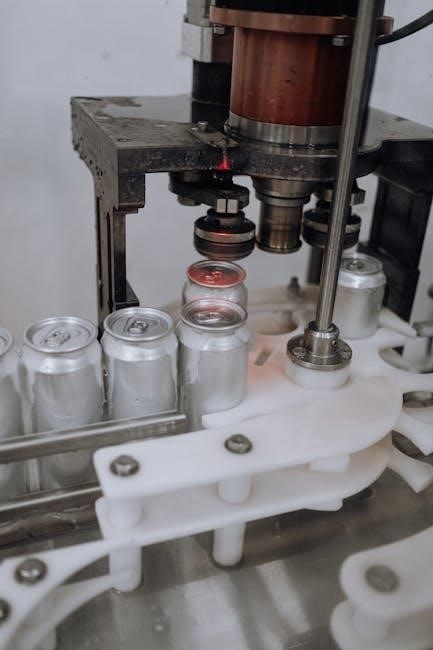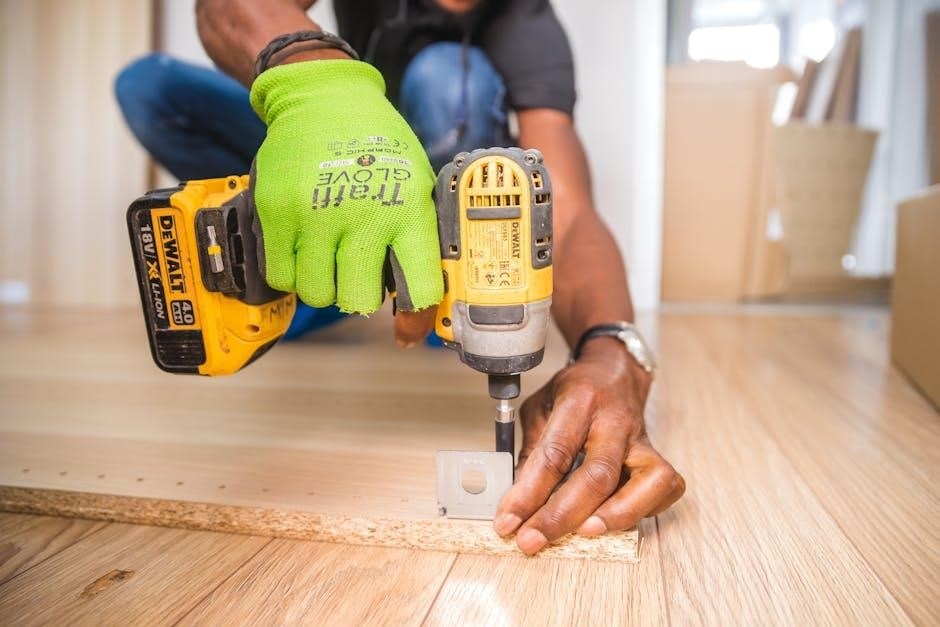AR-15 Complete Assembly Guide PDF: An Overview
This comprehensive overview introduces the AR-15 complete assembly guide PDF, a resource designed to aid both novice and experienced builders. It details the essential steps, tools, and considerations involved in assembling an AR-15 rifle, emphasizing safety and optimal performance, providing a valuable reference for understanding the AR-15 platform.

Essential Tools for AR-15 Assembly
Assembling an AR-15 requires a specific set of tools to ensure proper functionality and safety. A well-equipped workspace is crucial for a successful build. Essential tools include an AR-15 armorer’s wrench, which is vital for torquing the barrel nut and castle nut to the correct specifications, ensuring proper barrel alignment and buffer tube retention. A set of roll pin punches, in various sizes, is necessary for installing and removing roll pins without damaging the receiver or parts.
A quality torque wrench is indispensable for achieving precise torque values, especially for the barrel nut, which directly impacts accuracy. A vise block set, designed for both upper and lower receivers, provides a stable platform for assembly and prevents damage during the process. A hammer, preferably a nylon or brass-faced one, is needed for driving in pins without marring the finish. Additionally, a set of screwdrivers, including a properly sized Phillips head, is essential for various tasks.
Other helpful tools include a pin detent tool for managing small springs and detents, a bolt catch installation tool, and a magazine catch tool. Having these essential tools readily available will streamline the assembly process and contribute to a reliable and functional AR-15 build, following the guidance in your AR-15 complete assembly guide PDF.

Lower Receiver Assembly: A Step-by-Step Guide
This section provides a detailed, step-by-step guide for assembling the AR-15 lower receiver. It covers each component installation, offering clear instructions and helpful tips. Proper assembly ensures functionality and safety, aligning with the AR-15 complete assembly guide PDF’s recommendations.
Installing the Lower Receiver Parts Kit
Installing the lower receiver parts kit is a crucial step in building your AR-15. This process involves carefully placing and securing various small components, each essential for the rifle’s operation. The AR-15 complete assembly guide PDF provides detailed instructions to ensure proper installation.
Begin by identifying all the parts included in the kit: the trigger, hammer, disconnector, safety selector, bolt catch, magazine release, and various springs and pins. It’s important to have a clear understanding of each part’s function and placement before starting.
The process typically starts with installing the trigger and hammer, followed by the disconnector. Pay close attention to the orientation of each part and the correct placement of the corresponding springs. The safety selector and bolt catch are next, requiring careful manipulation and the use of appropriate tools, such as punches.
The magazine release and associated spring can be tricky, so patience is key. Finally, ensure all parts are properly seated and functioning smoothly. This detailed process, as outlined in the AR-15 complete assembly guide PDF, ensures a functional and safe lower receiver assembly.
Upper Receiver Assembly: A Detailed Walkthrough
This section provides a detailed walkthrough of the upper receiver assembly, guiding you through each step with clear instructions. The AR-15 complete assembly guide PDF ensures a proper build, covering critical aspects for optimal performance and reliability of your AR-15 rifle.
Barrel and Gas System Installation
Installing the barrel and gas system is a crucial step in the AR-15 upper receiver assembly. This stage directly impacts the rifle’s accuracy and reliability. Proper alignment of the gas block is essential for optimal cycling. First, apply a thin layer of grease to the barrel extension. Then, carefully slide the barrel into the upper receiver, ensuring it seats correctly. Next, install the barrel nut and torque it to the manufacturer’s specifications, using the appropriate wrench.
After the barrel nut is properly torqued, proceed with the gas block installation. Ensure the gas port is aligned with the corresponding hole in the barrel. Secure the gas block using the provided screws, tightening them evenly. Finally, attach the gas tube, making sure it’s properly seated in the gas block and aligned with the upper receiver.
This process demands precision and attention to detail. The AR-15 complete assembly guide PDF provides comprehensive instructions and diagrams for correct installation. Following these guidelines ensures the barrel and gas system function effectively, contributing to the overall performance of the AR-15 rifle.

Critical Steps for Optimal Performance
Achieving optimal AR-15 performance relies on several critical steps during assembly. These include precise barrel nut torquing, proper gas system alignment, and meticulous component fitting. Adhering to manufacturer specifications and utilizing the AR-15 complete assembly guide PDF ensures reliability and accuracy.
Torquing the Barrel Nut
Torquing the barrel nut is a critical step in AR-15 assembly, directly impacting the rifle’s accuracy and overall performance. The barrel nut secures the barrel to the upper receiver, and proper torque ensures correct headspace and prevents loosening during operation. Using the AR-15 complete assembly guide PDF is highly recommended for understanding the correct procedure.
The process requires a torque wrench and a specialized AR-15 armorers wrench. Ensure the upper receiver is securely mounted in a vise with appropriate upper receiver blocks to prevent damage. Apply the specified torque value from the manufacturer, typically ranging from 30 to 80 foot-pounds, while aligning the gas tube hole.
It is vital to follow a specific torque sequence. Tighten the nut to the minimum torque value, then incrementally increase the torque, aligning the gas tube hole with the next available notch on the barrel nut. Avoid over-torquing, which can damage the receiver or barrel. If the gas tube hole is misaligned even after reaching the maximum torque, the nut must be loosened and the process repeated.
Proper torquing guarantees a stable and accurate platform for the AR-15.
Disassembly and Maintenance of the AR-15
Disassembly and maintenance are crucial for ensuring the longevity and reliability of your AR-15. Regular cleaning and lubrication prevent malfunctions and maintain optimal performance. The AR-15 complete assembly guide PDF provides detailed instructions for safely disassembling your rifle for routine maintenance.
Before starting, ensure the firearm is unloaded. Disassembly typically begins with separating the upper and lower receivers by pushing out the takedown and pivot pins. Next, the bolt carrier group and charging handle can be removed from the upper receiver. The bolt carrier group can then be further disassembled for thorough cleaning. Pay close attention to the gas rings, firing pin, and extractor, as these components are prone to fouling.
The lower receiver also requires attention. Remove the buffer and buffer spring, and inspect the trigger group, hammer, and safety selector. Clean all parts with appropriate solvents and brushes, removing carbon buildup and debris. After cleaning, lightly lubricate all moving parts with high-quality gun oil.
Reassemble the AR-15 following the reverse order of disassembly. Regularly inspect your rifle for wear and tear, replacing worn parts as needed. Proper maintenance ensures your AR-15 remains a reliable and accurate firearm.

Troubleshooting Common Assembly Issues
Assembling an AR-15 can sometimes present challenges, even with a detailed guide. This section focuses on troubleshooting common assembly issues encountered during the build process, offering solutions to ensure a smooth and successful completion; One frequent problem is difficulty installing the bolt catch. This often arises from improper alignment or excessive force. Ensure the roll pin is started correctly and use a proper punch to drive it in gently.
Another common issue is a failure to extract or eject spent casings. This may stem from a faulty extractor spring or improper gas system installation. Verify the gas block is aligned correctly with the gas port on the barrel and that the gas tube is securely attached.
Sticking triggers are also a common complaint. This is often due to an incorrectly installed trigger spring or interference between the trigger and hammer. Double-check the spring orientation and ensure all parts are clean and properly lubricated. If the safety selector is difficult to move, examine the detent and spring for obstructions or damage.
Finally, if you encounter issues with magazine feeding, inspect the magazine catch and ensure it is properly engaging the magazine. By systematically addressing these common problems, you can overcome assembly challenges and build a reliable AR-15.
Free AR-15 Assembly Guide PDF Resources
This section provides a curated list of free AR-15 assembly guide PDF resources available online, offering valuable information for builders of all skill levels. These resources range from basic guides for first-time builders to more advanced documents detailing specific assembly techniques and troubleshooting tips. One excellent resource is a comprehensive guide often found on various firearm enthusiast forums, offering step-by-step instructions with clear diagrams.
Several manufacturers and retailers also provide free assembly guides as part of their product support. These guides are often tailored to their specific parts but can be helpful for understanding general AR-15 assembly principles.
Websites dedicated to firearm education and safety often host downloadable PDFs covering AR-15 assembly and maintenance. These resources typically emphasize safe handling practices and proper tool usage.
Additionally, online communities such as Reddit’s r/ar15 often share links to free assembly guides and offer peer-to-peer support for builders. However, always verify the credibility of the source before relying on any information. By utilizing these free resources, builders can gain valuable knowledge and confidence in their AR-15 assembly projects.
Safety Precautions During AR-15 Assembly
Prioritizing safety during AR-15 assembly is paramount, demanding meticulous attention to detail and adherence to established protocols. First and foremost, always ensure the firearm is unloaded before commencing any assembly or disassembly work. Double-check the chamber and magazine well to confirm they are empty.
Wear appropriate safety gear, including eye protection, to shield against projectiles or debris. A well-lit and organized workspace is essential to prevent accidents and ensure clear visibility. Consult and strictly follow the instructions provided in your AR-15 complete assembly guide PDF.
When handling springs and detents, exercise caution to prevent them from launching unexpectedly. Use appropriate tools to control these small parts and avoid injury. Be mindful of potential pinch points and sharp edges throughout the assembly process.
If using power tools, such as a torque wrench, adhere to the manufacturer’s safety guidelines and never exceed recommended torque specifications. Store all components and tools securely when not in use, keeping them out of reach of children and unauthorized individuals. By consistently practicing these safety precautions, you can minimize the risk of accidents and ensure a safe and enjoyable AR-15 building experience.
